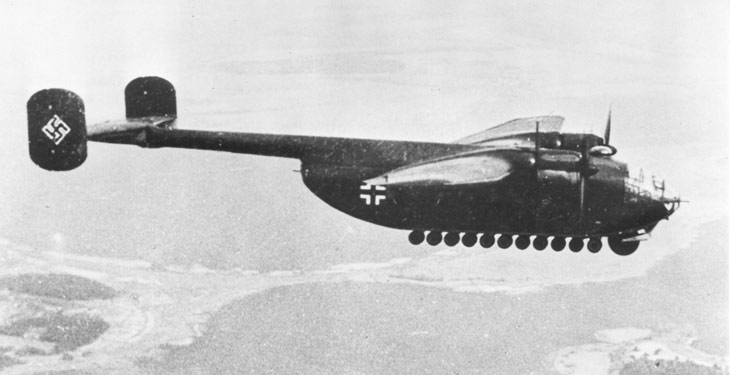Arado
Ar 232"Millipede"
The Arado Ar 232, nicknamed the "Millipede" by its German
pilots, was a cargo aircraft used by the Luftwaffe during the Second
World War. Only around 20 examples were ever built, despite the fact
it was a well-designed and capable transport aircraft.
The Arado Ar 232 was one of the first purpose designed cargo transport
aircraft ever built. From the ground up every aspect of the aircraft
was conceived to make the loading, unloading and transport of cargo
as easy and logical as possible.
It had a broad, box-shaped fuselage, a large rear loading ramp, a
stable high-wing design, a high tail boom which was well clear of
the rear doors, and a curiously designed undercarriage designed to
allow the aircraft to operate from rough fields and makeshift runways.

The aircraft was first proposed in 1939, with an order for three prototypes
placed in 1940. Unlike other cargo aircraft of the time - which generally
used side-mounted doors - the Ar 232 had hydraulically operated rear
clamshell doors. This made loading and unloading the aircraft quicker,
while also allowing for bulkier items to be easily carried.
The unusual landing gear of the Arado Ar 232 featured a conventional
retractable tricycle undercarriage which was supplemented by a row
of smaller wheels (hence the nickname) along the underside of the
fuselage. During normal operations the tricycle undercarriage was
used for takeoff and landings. However during loading the aircraft
could be lowered onto the smaller wheels for easier access. The row
of eleven wheels also meant that the Ar 232 could easily cross small
ditches and potholes when taxing - ideal for makeshift runways and
rough fields.
In addition to its rough field capability, the Arado Ar 232 was also
designed for short takeoff and landings. Full-length flaps at the
rear of the wing increased low-speed lift, while rockets could also
be used to assist during takeoff. Parachutes, or even reverse directed
rockets, could be used to shorten the landing distance.
The aircraft was manned by a crew of four. A pilot, navigator, radio
operator and a loadmaster. All the crew, with the exception of the
pilot, were also required to man the aircraft's three defensive machine
gun posts. The navigator operated a 13 mm (.51 in) MG 131 machine
gun in the nose, the radio operator a 20 mm MG 151 cannon in a rotating
turret on the roof, and the loadmaster a 13 mm (.51 in) MG 131 machine
gun firing rearward from the extreme rear of the cargo bay above the
cargo doors.
The first two prototypes were fitted with just two engines, but the
third and fourth prototypes, and all production aircraft were fitted
with four engines.
The aircraft was vastly superior to the Junkers Ju 52/3m transport
aircraft it was intended to replace. It could carry nearly double
the load over longer distances. It could operate from shorter and
rougher airstrips and it was faster. Yet despite all that only a small
number were ever produced as the Luftwaffe were more preoccupied with
producing better combat aircraft and never gave the project much support.
In the end the aircraft did act operationally, although most of the
aircraft produced never saw front-line roles and were instead used
to ferry parts between different aircraft factories.
Plans were drawn up for larger, more advanced versions of the design,
however these never got further than the drawing board.
Interestingly, two of the later models were captured by British forces
towards the end of the war. Renowned test pilot Eric "Winkle"
Brown, who flew the aircraft, remarked favorably on the design and
they were later used by the Royal Air Force for flights between Germany
and the UK after the war.
|

